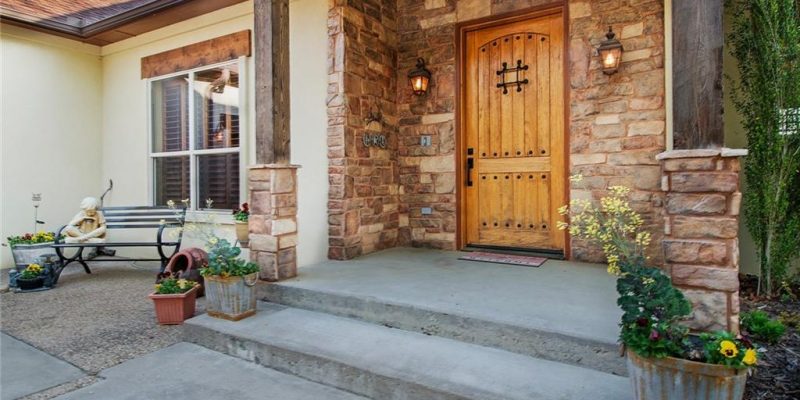Hardwood, laminate, tile, carpet, or luxury vinyl? How does one know which are the best flooring choices?
“Start with the end in mind — what is your vision for your home?” suggested Creswell Rozario, owner of The Floor Hut in Plano, Texas.
“There are many options available to suit your lifestyle incorporating particular design elements, practical requirements and budgetary constraints. You may choose to use varying flooring materials in different rooms of the home. Your best choice flooring show your personal preferences in color, texture and materials while considering high traffic areas, pets and more. It is quite thrilling to help customers make these decisions and see their visions become reality,” he said.
To help narrow the choices, here are some practical tips to consider.
Hardwood
Renovating a home and choosing new flooring can be a pretty daunting task considering the amount of options that you have available. One of the most commonly used materials for this purpose is hardwood and this comes with good reason—not only does it look great and lends warmth to any space it is used in, hardwood flooring also comes with a slew of other benefits. That said, to help you make a more informed decision, we’ll go through the pros and cons of using this material for your home.
Many homes boast beautiful hardwood floors which can be made from oak or exotic woods and can have finishes ranging from smooth, hand scraped, distressed, wire brushed and more. To help make the best choice for your particular home and need, it is best to see a professional who can guide your decisions.
Hardwood Pros:
- Easy to maintain. Hardwood floors are capable of withstanding the usual wear and tear that floors go through. If cared for properly, they can easily last a hundred years – some old houses have their floors intact despite the rest of the home going into disrepair. Maintenance does not require much. Just make sure that it is cleaned well and that you’re using the proper wood floor cleaner as some can be harsh and cause damage.
- With such a wide array of hardwood flooring types and prices, it can be an affordable option. They also provide you with great value for the money as you need not replace them for years. Think of it as an investment into the life of your home.
Hardwood Cons
- There is a cost to sand and varnish wood floors periodically. Depending on the kind of wood you’ve chosen, you may need to refinish it occasionally. This is particularly true for the softer wood varieties as they tend to get blemished and scratched more easily compared to others. You can do this yourself, but it does require a lot of work and can eat up a significant chunk of your time.
So, are hardwood floors worth the money? It all boils down to your personal preference and your budget. Of course, design is also a factor here. If you have the right resources and want to invest in something that will last, then this is a great option to look into.
Laminates
Do you like the look of tile floors, but hate how cold it can be for your feet in the heart of winter? Or maybe you always wanted hardwood flooring but were worried about what your children or pets might do to the finish, or more importantly, your investment.
If so, laminates may be the answer for you. With literally hundreds of styles and colors to choose from, laminates can approximate many hardwood and tile looks at a much more affordable price. Years past, laminate floors were relatively easy to spot. However, today’s technology allows manufacturers to create products such as strip wood with beveled edges, and ceramic tile with low-gloss grout lines, all to closely mimic the look of real wood and tile.
Here’s the thing about laminate floors: Not everyone thinks well of it. In fact, most people consider it to be quite tacky as it can look manufactured—taking away any unique features that would add an interesting detail to the space you plan on installing it in. However, with recent improvements in technology and design, many laminate varieties have taken on a more natural appearance, making them more appealing. So, if you’re thinking about using this particular type of flooring for your home, here are the pros and cons you might want to consider before making a final decision.
Laminate Pros:
- Glueless laminate floor installation. Even without professional help, you should be able to install about 300 square feet of laminate flooring in a single weekend. This is because more modern designs feature a fold/lock or click/lock system which basically means that you’ll be able to put each piece together like you would a puzzle. Since these are usually made out of soft particleboard, you can even cut them down to size easily should a bit of customization be needed. All you really need is a sharp utility knife or a handsaw. If you’re working with older laminate designs, however, do keep in mind that these would require you to glue each piece to the other. A slightly more tedious process, but still easier than other flooring options. Laminate maintenance simply involves sweeping regularly and using only a slightly damp mop. There are a few don’ts which include wet mopping, steaming the floors, using any pine scented or any oil based cleaners.
Laminate Cons
- Unlike other flooring material, laminate cannot be refinished in any way. If it gets tarnished or if any signs of wear and tear begin to show up, you will need to replace it. Of course, this requires money and if you are on a limited budget, this may not be the easiest thing to do.
Laminate flooring is great if you’re looking for ease when it comes to installation, and if your home does not go through heavy foot traffic. They are slightly more affordable than the other options, but do consider the need for replacing it after some time when working on a budget
Carpet
These days, not many people opt for carpeted flooring for their homes and would often consider this particular design feature as outdated. However, it cannot be denied that if you’re looking for a luxurious yet cozy feel to your home, carpets are sure to do the trick. For an extra touch of opulence, you can even opt for wall to wall carpeting instead of just using it in one particular area of the room.
Carpet Pros
- Can easily hide any flaws that your current flooring has. If it’s wood and has unsightly imperfections or if it is stained in any way and you wish to hide it, using carpets for this purpose is the easiest solution. Just be careful of the design and color you choose as it can easily make or break a space.
- Sound insulation. Aside from adding warmth to the space you put it in, using carpet for your flooring can also help cut down the amount of noise present in that area. It basically absorbs all of the sounds and prevents it from reverberating. Whether it be the movement of your kids or chatter within the family, carpets can help lessen its volume.
Carpet Cons
- Keep in mind that it actually retains both odors and stains. If you’re not careful, any occasional spills may remain as a stain for years until you choose to replace the carpet. The same goes if you have pets in your home; this is one of the many reasons why carpeted flooring isn’t recommended for households that have kids and pet animals.
- Costly maintenance. Compared to all the other options, carpeted floors are the most expensive when it comes to maintenance. Cleaning it alone, especially if done professionally, can set you back a few hundred dollars.
So, should you consider carpeted flooring? This all boils down to personal preference. While it isn’t the most cost-effective option, do know that it can really elevate a home’s entire appearance if used properly.
Tile
Two categories of tile include Natural Stone, or Porcelain and Ceramic. Natural Stone is, of course, a natural product. It exudes a beautiful organic look and comes in various forms such as granite, travertine, marble, and onyx. Porcelain and Ceramic tile are manufactured products which contain natural components. They are very easy to maintain and come in a nearly unlimited range of colors, sizes, and styles.
Tile offers beauty, general durability, and an array of design options. No longer relegated solely to bathrooms and kitchens, today’s tile flooring offers a wide range of versatility in terms of look and style. You can choose from a vast array of hues, colors, textures, and sizes to fit any budget and any lifestyle. From modern to rustic, traditional to southwest, tile flooring is one of the more popular flooring options for its ease of maintenance and incredible longevity.
Tile is a perfect choice for wet areas such as bathrooms and kitchens, as well as sun rooms, entry ways, patios, dining rooms, and living rooms. They resist moisture, stains, and discoloring and are very easy to care for.
Whether natural or porcelain/ceramic, indoor or outdoor, there is a tile to suit any use in any room throughout the home.
Is porcelain more durable than ceramic? The most common type of tile for home flooring would be porcelain, specifically because it is a lot more durable than the traditional ceramic variety. People typically opt for this if they’re trying to maintain a more contemporary aesthetic throughout their home. With the right color and finish, they can certainly make a space feel a lot more refined but in a very subtle manner. That said, there are a few pros and cons that you need to consider before deciding on this material for your home.
Tile Pros
- Very durable. Porcelain tiles are actually fired at a much higher temp when compared to ceramic ones. This means that its finish would be harder and its material is also a lot denser. These tiles are meant to last a lifetime if given ample care and maintenance.
- As it is a non-porous surface, cleaning is a breeze and no stains would stick to it. All you really need is a clean rag to wipe off any spills and you’re good to go. It is especially great for households that have kids – moms would definitely find cleaning up after their children much easier on tile flooring.
Tile Cons
- It is not DIY friendly. Most people these days prefer doing the bulk of the work when it comes to their home renovations. Not only would they be able to save money that way, but it also lends the work a more personal touch. Ceramic tiles, however, are a little hard to deal with and may require professional hands if you want the job done right.
These are just a few of the things you should consider when looking at different tiles to use as flooring for your home. Do keep in mind that there are other varieties aside from ceramic, so it all depends on your personal preference and needs. Always consider what would work best with your home before aesthetics.
Luxury Vinyl
Modern Luxury Vinyl is one of the most versatile and high-performing flooring options. Over the last few years Luxury Vinyl flooring has undergone extensive improvements in manufacturing quality and design. Now, numerous reputable flooring manufacturers produce durable, waterproof, comfortable Luxury Vinyl. While offering the same texture and visuals of natural products like wood and stone, Luxury Vinyl is also a fraction of the cost. Many lines of Luxury Vinyl come in a Fast Tack option, making it excellent for DIY projects. There is a vast selection of Luxury Vinyl to choose from. The Pros and Cons of Luxury Vinyl Flooring.
Want the look of natural wood or tile, but want something that’s more durable and appropriate for areas of your home that get a lot of foot traffic? If this is the case, then it’s time you look into vinyl plank flooring—they can mimic the appearance of wood and tile, but with a few other extra benefits that’ll certainly upgrade your home’s flooring.
But first, let’s talk style. Most people think vinyl planks are old-fashioned and quite comparable to laminate when it comes to the level of appeal it has. However, you might be surprised at the amount of options that you now have available—all thanks to modern tech. There’s a plethora of colors, textures and styles that would easily suit any design aesthetic that you’re after. The best bit? This is one of the most affordable options for flooring as well.
Luxury Vinyl Pros
- Easy to install and DIY friendly. You can put these on top of any existing hard flooring as the planks come with snaps that ensure a secure fit. Do watch out for any gaps, however, so you can avoid any water damage to the floor beneath it just in case you spill something.
- Maintenance is inexpensive. Much like tile floors and laminates, cleaning this material is fairly easy. It does not retain stains or odors so households with pets will certainly benefit from that.
- Unlike wood, you won’t see any scuff marks on vinyl. It would provide you with a similar look, but without the weaknesses wood flooring has.
Luxury Vinyl Cons
- One con is the fact that it can be quite slippery when wet. This can be curtailed with a few simple precautions, but it is important to consider nevertheless.
These are just a few things you should consider when purchasing luxury vinyl planks for your home. Remember that this comes in a number of different designs so always do a bit of research so you can find the best match for your home and personal needs.
Considering all of the flooring options available, with some research and due diligence, you can find the solutions to your flooring needs increasing the aesthetic and dollar value of your home.
Thanks to The Floor Hut in Dallas, Texas for this helpful consumer content. If you live in the Dallas Metro area, be sure to check out the pros at their Plano showroom who will help you make the best choices for all of your flooring needs.
Top Posts:
Recipes for Real Estate – Meals Help Make a House a Home
Is the Fall a Good Time to Sell Your Home
Rustic Elegance and Concrete…an Unusual Mix
Top 12 Best Home Builders in America
Beware of Over-improving Your Home


